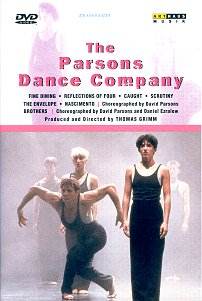This DVD showcases the work of a US dancer and choreographer
who established his own ensemble fifteen years ago and has created fifty
works for it since. The seven works here bear out the stress Parsons
lays in an introduction on the importance of variety in choreography
and of transforming everyday actions into staged spectacles without
losing their naturalness. This is not best demonstrated by showing him
in the lunch queue at a canteen. He collects his food from a whited
attendant and suddenly stares off into the middle distance - as ‘Fine
Dining’ suddenly and supposedly occurs to him. So skip the intro and
go straight to this unsettling, hyperactive piece set in a decayed ballroom
and given a decadent, desperate edge by a pulsating minimalist score
by David Linton which mixes instruments and electronics. A genteel elderly
couple is swept aside by a hip gang of eight whose increasingly erratic
movements are a fine parody of both the backbeat craze and the vanity
of youth. But the social commentary is less compelling than the sophistication
and exhilaration of the choreography, and this is true throughout. Touching
as the depiction of friendship and fraternal devotion is in Brothers,
it is the delicacy, strength and total control of muscle and sinew which
invite the viewer’s constant attention.
There is a hypnotic ease about the movement of Parsons’s
dedicated dancers, whether they move to the chirpy synthesisers of Scrutiny
or the zany collage of Rossini in Envelope. This last and Caught may
be the least rewarding pieces for more traditional balletomanes, but
for those who are able to see the funny side of classical ballet’s formal
gestures, Envelope’s satire offers a rewarding experience. Between each
piece Parsons offers mostly unpretentious commentary on his attitudes,
styles and aims.
The works here are all entirely different to each other
in look, mood, sound and character and pay eloquent tribute to the latitude
of Parsons’s mind, but perhaps the most compelling has no music for
most of its duration and no set; the only prop is water, in the form
of pools and later rain which alternately bathe and lash the four women
in Reflections of Four. Each protagonist reveals herself in solo scenes
which flip from vulnerable introversion to dramatic conflict, creating
four separate and sympathetic portrayals in the process. All four join
for a final pas-de-deux in which they support each other and Mozart’s
most sublime wind serenade supports them.
Fans of contemporary dance will certainly want to see
this, but it could grab anyone attracted by the latent beauty in human
movement.
Peter Quantrill


